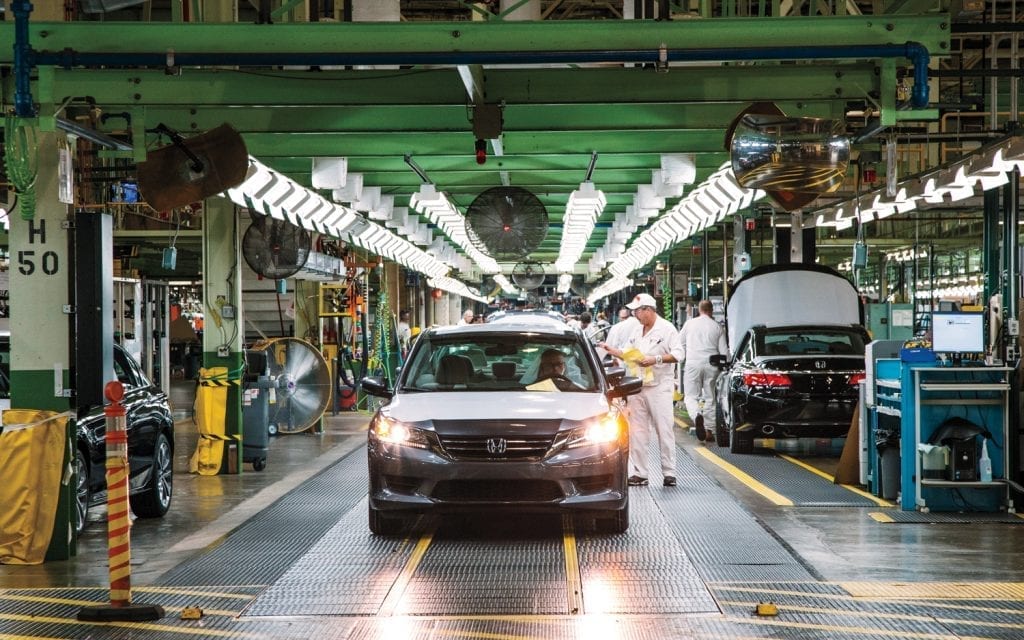
Honda Motor, long soft-spoken about its strategies for electric cars and autonomous driving in a world of raucous rivals, is suddenly talking louder.
Executives last week outlined bold goals to deliver lane-changing autonomous driving for highways by 2020 and then extend the effort to city streets with Level 4 self-driving vehicles by 2025.
At the same time, executives revealed that Honda has been quietly working on a range of electric vehicles under a new EV development division created in virtual secrecy in October.
That unit will deliver not only a dedicated EV for China next year, it is working on another EV that will be introduced at an auto show this fall — possibly targeting North America.
The revelations represent a leap forward for Japan’s No. 3 automaker as it races to catch up with competitors on the industry’s future technologies.
The sense of urgency was palpable among executives last week as they showcased their plans here.
“We have been lagging behind a little,” Honda R&D President Yoshiyuki Matsumoto said of the push, “so we are now trying to catch up. We are tightening the screws quickly.”
CEO Takahiro Hachigo unveiled the strategy as part of a new 2030 midterm business vision, saying engineers needed more concrete targets and a clear timeline to keep them on track.
At the same time, Honda has created two other divisions tasked with enhancing the perceived quality of its products and making them cheaper to develop and build. Honda wants to ensure that in a future in which self-driving EVs risk becoming like appliances, Honda cars will remain fun to drive.
Urgency
The sudden arrival of the plans reflects mounting pressure on Honda — a midsize global company, despite its appearance in the U.S. — to cope with industry consolidation, surging demand for costly new technologies and an onslaught of new competitors from Silicon Valley and China.
“It does seem like a lot of stuff just appeared out of thin air,” said Christopher Richter, senior auto analyst at CLSA Asia-Pacific Markets in Tokyo. “Now that the engineering juggernaut has been pointed in this direction, things will start moving.”
Honda has fallen behind traditional rivals such as Nissan Motor, Ford Motor and Volkswagen AG in chasing aggressive road maps for electric and self-driving vehicles. Moreover, upstarts such as Tesla, Waymo or even China’s LeEco, are opening new fronts of competition.
In its Japanese home market, the fiercely independent Honda suddenly finds itself as odd man out in a new era of partnerships. The domestic industry has coalesced into two camps, with Mazda Motor, Subaru and Suzuki Motor Corp. joining into loose alliance with Toyota Motor, and Mitsubishi Motors teaming with Nissan Motor.
Honda plans to spend big to make it all happen. The company will boost r&d spending 9.4 percent this year, to about $6.84 billion. But to demonstrate its competitive disadvantage in size, that commitment represents 5.3 percent of its forecasted revenue — larger rival Toyota will devote $9.57 billion to r&d this year, and that represents only 3.8 percent of its forecasted revenue.
The situation is not lost on Honda. Leveraging partners is now a top priority under Hachigo’s business plan.
Over the past year, Honda has deepened cooperation with General Motors in fuel cell vehicles, with Waymo in autonomous driving and with Hitachi in EV powertrains, among others.
Expect more collaborations going ahead, Hachigo said.
“We must secure higher competitiveness in automobile business for the future, especially in the areas of electrification and the realization of a collision-free society,” he said last week. “How we are going to achieve it remains the challenge.”
Staying Honda
Honda is wary of its vehicles falling into the commoditization that some forecast, in which automated EVs become bland by pulling together common parts and standardized electronics.
Making Honda stand out from the crowd will be the stickler, Hachigo said.
Honda set up a Product and Perceived Quality Planning Division in October to target the soft side of brand power, the subtle and hard-to-define nuances that connect people with their vehicles.
Driving dynamics will be a top focus for the new plan, and Honda has created a prototype vehicle called the Dynamic Study to embody some of its future ideas.
The concept vehicle is based on the current Civic sedan, with tweaks to the transmission, steering and chassis. Among them is a sporty downshift feature that revs like a stick shift when the car brakes into a curve, even though the transmission is automatic.
Honda also aims to make its cars look better. Hachigo said the company will debut a new design language in the fall, though the company declined to offer any sneak peeks.
Underpinning all these planned improvements will be doubled-down efforts to cut costs so vehicles brimming with ever-better technology won’t be priced out of the market.
“Solidifying our foundations to facilitate electrification and future technologies such as automated driving is the key to our future,” the CEO said. “That’s where we need to make solid changes this time.”

